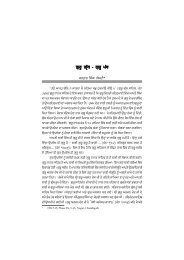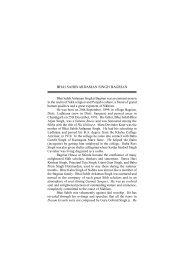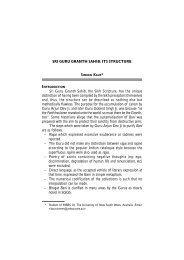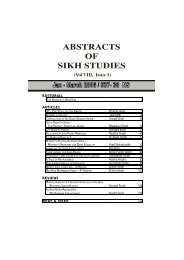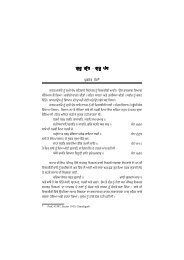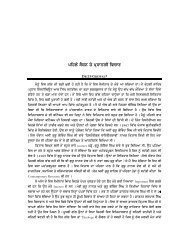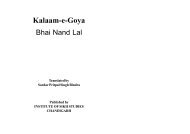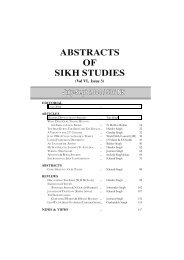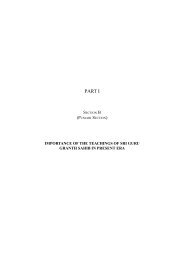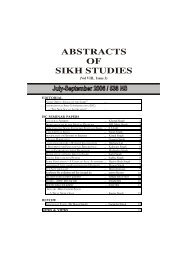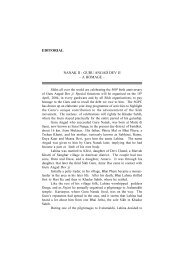editorial articles reviews news & views - Institute of Sikh Studies
editorial articles reviews news & views - Institute of Sikh Studies
editorial articles reviews news & views - Institute of Sikh Studies
Create successful ePaper yourself
Turn your PDF publications into a flip-book with our unique Google optimized e-Paper software.
MCLEOD & FENECH AS SCHOLARS ON SIKHISM AND MARTYRDOM<br />
89<br />
available, After Giani Ditt Singh’s death in 1901, the Chief Khalsa<br />
Dewan (founded 1902) played a prominent role in bringing together<br />
various Singh Sabhas. The Khalsa Samachar and the Khalsa Advocate,<br />
played a prominent role. Then followed the All India <strong>Sikh</strong> Educational<br />
Conference from 1907. Only those could be called <strong>Sikh</strong>s who emulated<br />
their ancestors. Petrie’s report <strong>of</strong> 1911 is to be seen in this light.<br />
The reports continue to mention <strong>of</strong> good work done by Master<br />
Tara Singh, Pr<strong>of</strong> Teja Singh, Sant Teja Singh, Bhai Takht Singh and<br />
others, on the powers <strong>of</strong> amrit and katha to inspire Khalsaisation <strong>of</strong><br />
the <strong>Sikh</strong>s. It was this that institutionalized the <strong>Sikh</strong> spirit ‘shorn <strong>of</strong><br />
Hindu influence’. Fenech must know that became not the dominant<br />
but an inherent feature in Tat Khalsa interpretation <strong>of</strong> the <strong>Sikh</strong><br />
tradition, and it was this spirit that liberated the <strong>Sikh</strong> Gurdwaras from<br />
the enemy.<br />
VIII<br />
The thesis now comes to its last chapter “Playing the Game: The<br />
Movement For Gurdwara Reform, 1920-25”. Harjot Oberoi’s work<br />
The Construction <strong>of</strong> Religious Boundaries, Culture, Identity and Diversity in<br />
<strong>Sikh</strong> Tradition, (Delhi, 1994), too comes to a close at this very juncture.<br />
Why The answer is obvious. By 1925, the <strong>Sikh</strong> identity had been<br />
completely established, shorn <strong>of</strong> fulminations by malcontents like M.K.<br />
Gandhi, the so-called father <strong>of</strong> the nation, and others. The attempts<br />
<strong>of</strong> people like Fenech come to a close as their effort to impose Hindu<br />
multi-culturation, like the scenario in 19th century comes to a close.<br />
It is another matter that it restarted in post-1947 era with Hinduism’s<br />
regaining its pristine glory.<br />
It is quite remarkable that Harjot Oberoi provides the first<br />
paragraph <strong>of</strong> his gur-bhai’s last chapter as there is an identity <strong>of</strong> outlook<br />
between the followers <strong>of</strong> McLeod. It was not only the powerful rhetoric<br />
<strong>of</strong> martyrdom as suggested by Fenech but the Tat Khalsa’s rhetoric <strong>of</strong><br />
the <strong>Sikh</strong>s and <strong>Sikh</strong>ism that came to be seen the only interpretation <strong>of</strong><br />
the <strong>Sikh</strong> tradition. It also must be stated here unlike Fenech and his<br />
guru McLeod, that the Hindus who were an essential part <strong>of</strong> these<br />
efforts to mix up the <strong>Sikh</strong> identity, were essential part <strong>of</strong> this <strong>Sikh</strong>



